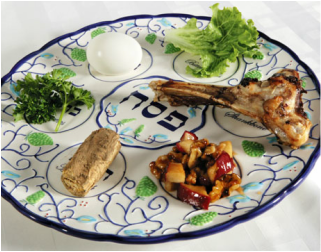Holy Week Celebration #1 - Passover
|
We know that during Holy Week, Jesus was in Jerusalem celebrating the Jewish Passover with the rest of his community. Practicing this ties us to the rich heritage of faith that precedes Christianity.
Read It
Exodus 12:21-27 And when your children ask you, ‘What do you mean by this observance?’ you shall say, ‘It is the passover sacrifice to the Lord, for he passed over the houses of the Israelites in Egypt, when he struck down the Egyptians but spared our houses.’” And the people bowed down and worshiped. Exodus 12:26-27 -NRSV |
Do It
Passover (Seder) – an out-of-the-fridge, no-special-shopping-required way to celebrate the Passover with your children
Passover (Seder) – an out-of-the-fridge, no-special-shopping-required way to celebrate the Passover with your children
- Gather the supplies: Matza (or crackers, if you don’t have time to go to the store), greens (parsley is traditional, but lettuce, celery, or any other herb works fine), hard-boiled or roasted eggs, horseradish, salt water, applesauce (if you want to get more authentic, add some nuts and cinnamon to it), piece of roasted lamb (or whatever meat you have – just not pork!).
- Prepare the plates: Put a small amount of each food item except Matza on plates for each member of your family. Put salt water in one bowl for the whole table, or give each person a small bowl.
- Read the scripture (long version or short, depending on your family’s needs), and explain that tonight we’re going to do what God’s people have done throughout history, and what Jesus did with his disciples.
- Eat the foods of the Seder meal together, explaining as you eat them:
- Dip some of the greens in the salt water and eat it. God’s people were crying, because others were not being kind to them. This salt water reminds us of their tears. The greens are like the people of God – they taste good as they are, but if they are left in the ground for too long they become bitter. God’s people were like that, they were becoming bitter because they didn’t know God was listening to them. We eat this to remember that the people of God were crying out for God’s help.
- Break the Matza or crackers. Hide part of it in a napkin in the middle of the table.
- Eat some of the Matza, and talk about how God heard the people’s cry for help, and they had to escape in the middle of the night. That meant their bread didn’t have time to rise, so it was hard like this “bread” we’re eating.
- Dip some more of the lettuce into the applesauce. The people of God had to work very hard to make big buildings for the people who weren’t being kind to them. This applesauce reminds us of the mortar they used when they built.
- Dip some Matza or lettuce in horseradish and eat it. That doesn’t taste very good, does it? We call that a bitter taste. Being in slavery was bitter for the people of God. They needed help.
- Eat the meat and egg (and finish other elements of the meal that haven’t been eaten yet). The egg reminds us of the offerings that people brought to the temple to thank God for saving them. The meat reminds us of the lamb that the families butchered and put on their door frames so the spirit of God would know to pass over their houses (we left the meat out of our meal).
- Where’s the piece we hid? Do you know why we hide that piece? It represents the Messiah. When people started celebrating the Passover, Jesus hadn’t come yet. So they hid that piece because they were waiting for him. Find and eat the hidden Matza.
Pray It
Thank you, God, for the way you hear our cries and deliver us. Thank you for this story that we can remember tonight. Help us to be your people. In Jesus’ name, Amen.
Thank you, God, for the way you hear our cries and deliver us. Thank you for this story that we can remember tonight. Help us to be your people. In Jesus’ name, Amen.
Extras
If you want a more authentic and elaborate way to celebrate, especially good for ages 4 and up.
If you want a more authentic and elaborate way to celebrate, especially good for ages 4 and up.

